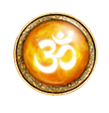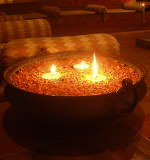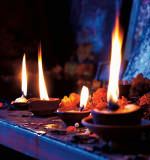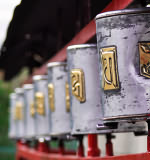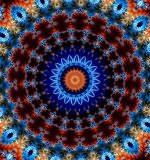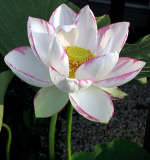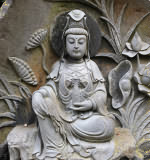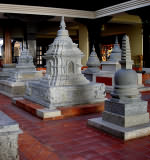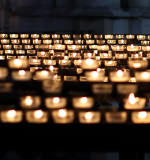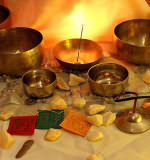| Töltsd le és telepítsd a nélkülözhetetlen betűtípusokat(s) Hogy megtekinthesd a Szanszkritot annak teljes fényében Olvass Transzliteráció (2) (magyar) hogy teljes mértékben átlásd a transzliterációs rendszert |
Tanulj Szanszkritul - Transzliteráció (2) (Hungarian)
A transzliterációs rendszerek összehasonlítása
Introduction
Gabriel Pradīpaka again. I have realized that some people have problems with the systems of transliteration. The systems of transliteration are useful because through them one can write in Szanszkrit without using the original script (Devanāgarī). Even those people knowing Devanāgarī must often use some transliteration scheme for the sake of convenience when teaching something related to Szanszkrit, Yoga, etc. to the vulgar mortals. Those "Immortal" beings must use, whether or not they like, some transliteration system so that the "common" human beings may understand their words and explanations, hehe.
I myself, as one of those "Immortal" beings, have to use generally IAST (International Alphabet of Szanszkrit Transliteration) so that most pupils (still mortals) may read and write Szanszkrit terms. Joking apart, my explanation of why to use transliteration systems is true. For instance, if, during a class for beginners, I tell "Paramaśiva" (Supreme Śiva or God), and when asked how to write that word, I would write:
परमशिव
Well... it would not be really didactic, haha. That is why, I have to use a particular transliteration system in Roman script. When teaching, I use IAST (as I said before) for the greater part. Thus, I would write:
Paramaśiva
It is much more pupil-friendly, isn't it? Granted, if you did not read Transliterating (1) (English), it is possible that you may wonder, "what the heck is that 's' with a written accent on it?" It is the first sibilant.
Apart from IAST (International Alphabet of Szanszkrit Transliteration), there are many other systems, but two are very important: ITRANS and Harvard-Kyoto. ITRANS is used throughout the Internet by a lot of people. For example, if you want to write something in Szanszkrit on a forum, you will have to use ITRANS generally. It is also used in some important software tools as we will see later. For that reason, it is crucial to know ITRANS. Besides ITRANS, there is another celebrated transliteration system called "Harvard-Kyoto". This system is also a usual one.
I will teach you each of those systems one by one, and after that all at the same time. And afterward, you will be able to see some comparative examples in IAST, ITRANS and Harvard-Kyoto.
But firstly, the Szanszkrit alphabet in Devanāgarī (original script). Let us get down to work!
Szanszkrit alphabet in DEVANĀGARĪ
Devanāgarī is the name of the original script to write in Szanszkrit. It is the current alphabet to write Szanszkrit in a proper way. It consists of many characters (signs) that will look like something written by an alien to the vulgar mortal. If you are brave enough, and want to know how to write in Devanāgarī, visit Writing for more information. There I will show you how to go beyond your miserable mortality and turn into an Immortal being who knows how to write in Devanāgarī, hehe. Note that I will display the alphabet without adding "a" to the consonants, Anusvāra and Visarga as usual. Besides, I have added "ḹ", a theoretical vowel that it does not occur in the formal alphabet really. See the formal Szanszkrit alphabet and compare. I am doing all those changes for the sake of convenience, as you will see later. I will be using Virāma (a stroke downward) under each of the consonants to remove "a" from them. The "reformed" alphabet now:
| Devanāgarī | |||||||||||||||
| Vowels | |||||||||||||||
| अ | आ | इ | ई | उ | ऊ | ऋ | ॠ | ऌ | ॡ | ए | ऐ | ओ | औ |
 |
: |
| Consonants | |||||||||||||||
| First Group | |||||||||||||||
| Subgroups | Hard | Soft | |||||||||||||
| Unaspirate | Aspirate | Unaspirate | Aspirate | Nasals | |||||||||||
| Gutturals | क् | ख् | ग् | घ् | ङ् | ||||||||||
| Palatals | च् | छ् | ज् | झ् | ञ् | ||||||||||
| Cerebrals (Cacuminals) | ट् | ठ् | ड् | ढ् | ण् | ||||||||||
| Dentals | त् | थ् | द् | ध् | न् | ||||||||||
| Labials | प् | फ् | ब् | भ् | म् | ||||||||||
| Second Group | |||||||||||||||
| Semivowels | य् | र् | ल् | व् | |||||||||||
| Third Group | |||||||||||||||
| Sibilants | श् | ष् | स् | ||||||||||||
| Fourth Group | |||||||||||||||
| Sonant Aspirate | ह् | ||||||||||||||
Other common characters now:
| क्ष् | ज्ञ् | ऽ |
 |
ॐ |
| Two usual conjuncts | Avagraha or apostrophe | Anunāsika | The sacred word Om | |
Szanszkrit alphabet in IAST
The same reformed alphabet as before, but now in IAST (International Alphabet of Szanszkrit Transliteration). Remember that this transliteration scheme is very often used "offline" (books, documents, etc.) and also by us on this website. Note that all letters are only in lowercase. The sacred word "Om̐" begins with a capital letter though. You may wonder: Where the heck do I get a transliteration font using IAST? The answer is very simple:
There is a very good font (URW Palladio IT). This font is used by Itranslator 99 (software to write easily in Szanszkrit). You can also use URW Palladio ITU (the font that is used in Itranslator 2003), but you must have Windows 2000 (and higher) in order for it to work, because it is Unicode. Also remember that Itranslator 99 and Itranslator 2003 use the fonts Szanszkrit 99 and Szanszkrit 2003, respectively, to show Devanāgarī characters. In short, Itranslator 99 uses Szanszkrit 99 and URW Palladio IT fonts, while Itranslator 2003 utilizes Szanszkrit 2003 and URW Palladio ITU fonts.
| IAST | |||||||||||||||
| Vowels | |||||||||||||||
| a | ā | i | ī | u | ū | ṛ | ṝ | ḷ | ḹ | e | ai | o | au | ṁ or ṃ1 |
ḥ |
| Consonants | |||||||||||||||
| First Group | |||||||||||||||
| Subgroups | Hard | Soft | |||||||||||||
| Unaspirate | Aspirate | Unaspirate | Aspirate | Nasals | |||||||||||
| Gutturals | k | kh | g | gh | ṅ | ||||||||||
| Palatals | c | ch | j | jh | ñ | ||||||||||
| Cerebrals (Cacuminals) | ṭ | ṭh | ḍ | ḍh | ṇ | ||||||||||
| Dentals | t | th | d | dh | n | ||||||||||
| Labials | p | ph | b | bh | m | ||||||||||
| Second Group | |||||||||||||||
| Semivowels | y | r | l | v | |||||||||||
| Third Group | |||||||||||||||
| Sibilants | ś | ṣ | s | ||||||||||||
| Fourth Group | |||||||||||||||
| Sonant Aspirate | h | ||||||||||||||
Other common characters now:
| kṣ | jñ | ' | m̐2 | Om̐ / Oṁ / Oṃ3 |
| Two usual conjuncts | Avagraha or apostrophe | Anunāsika | The sacred word Om | |
1 Two ways to write Anusvāra.
2 This is the "formal" way to write the Anunāsika character in IAST. Still, sometimes it is written like this: ~ or even the original character in Devanāgarī (half-moon plus dot) is often used. If you keyboard layout does not contain ~, then you need to apply the combination of keys Alt + 126 to generate it on the screen. Hold down the Alt key and write 126 by using the numbers placed at the right of your keyboard (not those placed above, careful!). Then, change the position to "superscript" and ready: ~. Of course, as this character is to be placed upon another letter, either the software that you use to write must be able to "overstrike" or you must use a capable font to do the trick (e.g. the Andika font contains Õ, and you can use it instead of Om̐). As it is obvious, since all this looks complicated, I recommed you to use the character "m̐" and that is it!
3 Three ways to write the sacred word by using Anunāsika and the two forms of Anusvāra. Nonetheless, sometimes it is written simply like this: Om.
Szanszkrit alphabet in ITRANS
ITRANS is very, very usual online (e.g. very handy with mails). I strongly recommend you learn this scheme, as it will be really useful for your online life. It will come in handy as well if you want to write in Szanszkrit with Itranslator 99 or 2003.
There are several versions of ITRANS, but here I will show you only two: 5.1 and 5.3. They are very similar, but some differences do exist. Look version 5.1 first (pay attention to lowercase and uppercase, as this difference is very important):
| ITRANS 5.1 | |||||||||||||||
| Vowels | |||||||||||||||
| a | aa / A | i | ii / I | u | uu / U | R^i | R^I | L^i | L^I | e | ai | o | au | .n/M/.m | H |
| Consonants | |||||||||||||||
| First Group | |||||||||||||||
| Subgroups | Hard | Soft | |||||||||||||
| Unaspirate | Aspirate | Unaspirate | Aspirate | Nasals | |||||||||||
| Gutturals | k | kh | g | gh | ~N1 | ||||||||||
| Palatals | c | Ch | j | jh | ~n1 | ||||||||||
| Cerebrals (Cacuminals) | T | Th | D | Dh | N | ||||||||||
| Dentals | t | th | d | dh | n | ||||||||||
| Labials | p | ph | b | bh | m | ||||||||||
| Second Group | |||||||||||||||
| Semivowels | y | r | l | v/w | |||||||||||
| Third Group | |||||||||||||||
| Sibilants | sh | Sh | s | ||||||||||||
| Fourth Group | |||||||||||||||
| Sonant Aspirate | h | ||||||||||||||
Other common characters now:
| x/kSh | GY/j~n/dny1 | .a | .N | OM/AUM |
| Two usual conjuncts | Avagraha or apostrophe | Anunāsika | The sacred word Om | |
1 If you keyboard layout does not contain ~, you need to use the combination of keys Alt + 126 to generate it on the screen. Hold down the Alt key and write 126 by using the numbers placed at the right of your keyboard (not those placed above, careful!).
Look version 5.3 now (pay attention to lowercase and uppercase, as this difference is very important). Moreover, I have highlighted the scanty differences with regard to the version 5.1 in light yellow color:
| ITRANS 5.3 | |||||||||||||||
| Vowels | |||||||||||||||
| a | aa / A | i | ii / I | u | uu / U | R^i/RRi | R^I/RRI | L^i/LLi | L^I/LLI | e | ai | o | au | .n/M/.m | H |
| Consonants | |||||||||||||||
| First Group | |||||||||||||||
| Subgroups | Hard | Soft | |||||||||||||
| Unaspirate | Aspirate | Unaspirate | Aspirate | Nasals | |||||||||||
| Gutturals | k | kh | g | gh | ~N1 | ||||||||||
| Palatals | c | Ch | j | jh | ~n1 | ||||||||||
| Cerebrals (Cacuminals) | T | Th | D | Dh | N | ||||||||||
| Dentals | t | th | d | dh | n | ||||||||||
| Labials | p | ph | b | bh | m | ||||||||||
| Second Group | |||||||||||||||
| Semivowels | y | r | l | v/w | |||||||||||
| Third Group | |||||||||||||||
| Sibilants | sh | Sh | s | ||||||||||||
| Fourth Group | |||||||||||||||
| Sonant Aspirate | h | ||||||||||||||
Other common characters now:
| x/kSh | GY/j~n/dny1 | .a | .N | OM/AUM |
| Two usual conjuncts | Avagraha or apostrophe | Anunāsika | The sacred word Om | |
1 If you keyboard layout does not contain ~, you need to use the combination of keys Alt + 126 to generate it on the screen. Hold down the Alt key and write 126 by using the numbers placed at the right of your keyboard (not those placed above, careful!).
Some older than version 5.1 characters in ITRANS:
- N^ (~N in ITRANS 5.1 and 5.3)
- ch (c in ITRANS 5.1 and 5.3)
- chh (Ch in ITRANS 5.1 and 5.3)
- JN (~n in ITRANS 5.1 and 5.3)
- shh/Z/S (Sh in ITRANS 5.1 and 5.3)
- ksh/kS (x/kSh in ITRANS 5.1 and 5.3)
In Itranslator you may use these old characters too.
Szanszkrit alphabet in Harvard-Kyoto
I strongly recommend you learn Harvard-Kyoto, since it might come in handy in your online life. It is vital to know ITRANS and Harvard-Kyoto to surf Szanszkrit-related sites. Harvard-Kyoto is very simple. Look (careful with lowercase and uppercase):
| Harvard-Kyoto | |||||||||||||||
| Vowels | |||||||||||||||
| a | A | i | I | u | U | R | RR | lR | lRR | e | ai | o | au | M | H |
| Consonants | |||||||||||||||
| First Group | |||||||||||||||
| Subgroups | Hard | Soft | |||||||||||||
| Unaspirate | Aspirate | Unaspirate | Aspirate | Nasals | |||||||||||
| Gutturals | k | kh | g | gh | G | ||||||||||
| Palatals | c | ch | j | jh | J | ||||||||||
| Cerebrals (Cacuminals) | T | Th | D | Dh | N | ||||||||||
| Dentals | t | th | d | dh | n | ||||||||||
| Labials | p | ph | b | bh | m | ||||||||||
| Second Group | |||||||||||||||
| Semivowels | y | r | l | v | |||||||||||
| Third Group | |||||||||||||||
| Sibilants | z | S | s | ||||||||||||
| Fourth Group | |||||||||||||||
| Sonant Aspirate | h | ||||||||||||||
Other common characters now:
| kS | jJ | ' | .m | o.m or oM 1 |
| Two usual conjuncts | Avagraha or apostrophe | Anunāsika | The sacred word Om | |
1 Note that the vowel "o" remains lowercase, careful! You can write it "om" too.
And now, all transliteration systems will be shown simultaneously:
Comparing all alphabets
Well, all alphabets I have just explained to you will be shown together. The color code indicates the alphabet which is being used. I do not know if the color choice is the best, but at least it clearly shows you each of the transliteration alphabets. Besides, these colors belong to the theoretical 216-color web-safe palette, as there are only 212 web-safe colors in practice. A web-safe color is one that appears the same on Internet Explorer and Mozilla-based browsers, whether on Windows or Macintosh systems, when running in 256-color mode:
| Devanāgarī | IAST | ITRANS 5.1 | ITRANS 5.3 | Harvard-Kyoto |
| Vowels | |||||||||||||||
| अ | आ | इ | ई | उ | ऊ | ऋ | ॠ | ऌ | ॡ | ए | ऐ | ओ | औ |
 |
: |
| a | ā | i | ī | u | ū | ṛ | ṝ | ḷ | ḹ | e | ai | o | au | ṁ or ṃ |
ḥ |
| a | aa / A |
i | ii / I |
u | uu / U |
R^i | R^I | L^i | L^I | e | ai | o | au | .n/ M/ .m |
H |
| a | aa / A |
i | ii / I |
u | uu / U |
R^i / RRi |
R^I/ RRI |
L^i / LLi |
L^I / LLI |
e | ai | o | au | .n/ M/ .m |
H |
| a | A | i | I | u | U | R | RR | lR | lRR | e | ai | o | au | M | H |
| Consonants | |||||||||||||||
| First Group | |||||||||||||||
| Subgroups | Hard | Soft | |||||||||||||
| Unaspirate | Aspirate | Unaspirate | Aspirate | Nasals | |||||||||||
| Gutturals | क् | ख् | ग् | घ् | ङ् | ||||||||||
| k | kh | g | gh | ṅ | |||||||||||
| k | kh | g | gh | ~N | |||||||||||
| k | kh | g | gh | ~N | |||||||||||
| k | kh | g | gh | G | |||||||||||
| Palatals | च् | छ् | ज् | झ् | ञ् | ||||||||||
| c | ch | j | jh | ñ | |||||||||||
| c | Ch | j | jh | ~n | |||||||||||
| c | Ch | j | jh | ~n | |||||||||||
| c | ch | j | jh | J | |||||||||||
| Cerebrals (Cacuminals) | ट् | ठ् | ड् | ढ् | ण् | ||||||||||
| ṭ | ṭh | ḍ | ḍh | ṇ | |||||||||||
| T | Th | D | Dh | N | |||||||||||
| T | Th | D | Dh | N | |||||||||||
| T | Th | D | Dh | N | |||||||||||
| Dentals | त् | थ् | द् | ध् | न् | ||||||||||
| t | th | d | dh | n | |||||||||||
| t | th | d | dh | n | |||||||||||
| t | th | d | dh | n | |||||||||||
| t | th | d | dh | n | |||||||||||
| Labials | प् | फ् | ब् | भ् | म् | ||||||||||
| p | ph | b | bh | m | |||||||||||
| p | ph | b | bh | m | |||||||||||
| p | ph | b | bh | m | |||||||||||
| p | ph | b | bh | m | |||||||||||
| Second Group | |||||||||||||||
| Semivowels | य् | र् | ल् | व् | |||||||||||
| y | r | l | v | ||||||||||||
| y | r | l | v/w | ||||||||||||
| y | r | l | v/w | ||||||||||||
| y | r | l | v | ||||||||||||
| Third Group | |||||||||||||||
| Sibilants | श् | ष् | स् | ||||||||||||
| ś | ṣ | s | |||||||||||||
| sh | Sh | s | |||||||||||||
| sh | Sh | s | |||||||||||||
| z | S | s | |||||||||||||
| Fourth Group | |||||||||||||||
| Sonant Aspirate | ह् | ||||||||||||||
| h | |||||||||||||||
| h | |||||||||||||||
| h | |||||||||||||||
| h | |||||||||||||||
Other common characters now:
| क्ष् | ज्ञ् | ऽ |
 |
ॐ |
| kṣ | jñ | ' | m̐ | Om̐ / Oṁ / Oṃ |
| x/kSh | GY/j~n/dny | .a | .N | OM/AUM |
| x/kSh | GY/j~n/dny | .a | .N | OM/AUM |
| kS | jJ | ' | .m | o.m/oM/om |
| Two usual conjuncts | Avagraha or apostrophe | Anunāsika | The sacred word Om | |
Comparative examples
Ah!, so you want some example to understand how the things work in practice. Well, I have heard your desires. Firstly, a few words and then some Szanszkrit prose.
I will be using the same color scheme as before. I frequently use written accent on the site (with IAST) to show the proper pronunciation. This written accent might be used in IAST now again, but I have preferred to write the following words without it for the sake of pure convenience. When you search for a term on an online dictionary, no written accent should be utilized in general. Note that uppercase for the first letter of a sentence, proper noun, etc. is not usually used in ITRANS and Harvard-Kyoto, since that might be mistaken for a different character "originally" included in those transliteration schemes. For example, if you write "MahAbhArata" (the name of the celebrated epic poem) in ITRANS, initial "M" might be mistaken for Anusvāra (M). Therefore, you must write "mahAbhArata". Careful here! Make sure that you will follow my previous advise when using Itranslator 99 or 2003, or you will get awful results, as those programs use ITRANS.
However, you can use freely uppercase in IAST, as there is no character in uppercase "originally" included in this scheme. That is why I will insert an initial capital letter when writing proper nouns in IAST.
A last thing: I will not translate the words I will list. If you want to find out their meanings, copy the terms in Harvard-Kyoto or ITRANS and search them in the IITS Koeln (an online dictionary we recommend - note that in this dictionary IAST is called Roman Unicode):
| Devanāgarī | IAST | ITRANS 5.1 | ITRANS 5.3 | Harvard-Kyoto |
| आसन | āsana | aasana/Asana | aasana/Asana | Asana |
| ऋषि | ṛṣi | R^iShi | R^iShi RRiShi |
RSi |
| योग | Yoga | yoga | yoga | yoga |
| संस्कृत | Saṁskṛta / Saṃskṛta | sa.nskR^ita saMskR^ita sa.mskR^ita |
sa.nskR^ita sa.nskRRita saMskR^ita saMskRRita sa.mskR^ita sa.mskRRita |
saMskRta |
| शिव | Śiva | shiva | shiva | ziva |
| महाभारत | Mahābhārata | mahaabhaarata mahAbhArata |
mahaabhaarata mahAbhArata |
mahAbhArata |
| कृष्ण | Kṛṣṇa | kR^iShNa | kR^iShNa kRRiShNa |
kRSNa |
| राम | Rāma | raama | raama | rAma |
| अन्तःकरण | antaḥkaraṇa | antaHkaraNa | antaHkaraNa | antaHkaraNa |
| ज्ञान | jñāna | GYaana/GYAna j~naana/j~nAna dnyaana/dnyAna |
GYaana/GYAna j~naana/j~nAna dnyaana/dnyAna |
jJAna |
| क्षोभ | kṣobha | xobha kShobha |
xobha kShobha |
kSobha |
| चक्र | cakra | cakra | cakra | cakra |
| सूत्र | sūtra | suutra sUtra |
suutra sUtra |
sUtra |
| इच्छा | icchā | icChaa icChA |
icChaa icChA |
icchA |
| प्रतिष्ठा | pratiṣṭhā | pratiShThaa pratiShThA |
pratiShThaa pratiShThA |
pratiSThA |
| मूलाधार | Mūlādhāra | muulaadhaara mUlAdhAra |
muulaadhaara mUlAdhAra |
mUlAdhAra |
| विकॢप् | vikḷp | vikL^ip | vikL^ip vikLLip |
viklRp |
| शास्त्र | śāstra | shaastra shAstra |
shaastra shAstra |
zAstra |
| पतञ्जलि | Patañjali | pata~njali | pata~njali | pataJjali |
| अङ्ग | aṅga | a~Nga | a~Nga | aGga |
Some prose now. I have chosen the second paragraph of the Kṣemarāja's narrative about the discovery of Śivasūtra-s by Vasugupta. I will use the same color codes as previously. A last thing: In case of multiple options in a particular transliteration scheme, I will be using only one (e.g. I will be using A for the long "a" in ITRANS, and not the other option, that is, "aa"). Why?... because the amount of possible alternative ways to write characters in some systems (e.g. ITRANS) would produce too many combinations. Thus, I would have to write the fragment too many times to show all those combinations within a scheme. Got it? Well done:
| Devanāgarī | IAST | ITRANS 5.1 | ITRANS 5.3 | Harvard-Kyoto |
| कदाचिच्चासौ द्वैतदर्शनाधिवासितप्राये जीवलोके रहस्यसम्प्रदायो मा विच्छेदीत्याशयतोऽनुजिघृक्षापरेण परमशिवेन स्वप्नेऽनुग्रह्योन्मिषितप्रतिभः कृतो यथात्र महीभृति महति शिलातले रहस्यमस्ति तदधिगम्यानुग्रहयोग्येषु प्रकाशयेति |
| Kadāciccāsau dvaitadarśanādhivāsitaprāye jīvaloke rahasyasampradāyo mā vicchedītyāśayato'nujighṛkṣāpareṇa paramaśivena svapne'nugrahyonmiṣitapratibhaḥ kṛto yathātra mahībhṛti mahati śilātale rahasyamasti tadadhigamyānugrahayogyeṣu prakāśayeti |
| kadAciccAsau dvaitadarshanAdhivAsitaprAye jIvaloke rahasyasampradAyo mA vicChedItyAshayato.anujighR^ikShApareNa paramashivena svapne.anugrahyonmiShitapratibhaH kR^ito yathAtra mahIbhR^iti mahati shilAtale rahasyamasti tadadhigamyAnugrahayogyeShu prakAshayeti |
| kadAciccAsau dvaitadarshanAdhivAsitaprAye jIvaloke rahasyasampradAyo mA vicChedItyAshayato.anujighRRikShApareNa paramashivena svapne.anugrahyonmiShitapratibhaH kRRito yathAtra mahIbhRRiti mahati shilAtale rahasyamasti tadadhigamyAnugrahayogyeShu prakAshayeti |
| kadAciccAsau dvaitadarzanAdhivAsitaprAye jIvaloke rahasyasampradAyo mA vicchedItyAzayato'nujighRkSApareNa paramazivena svapne'nugrahyonmiSitapratibhaH kRto yathAtra mahIbhRti mahati zilAtale rahasyamasti tadadhigamyAnugrahayogyeSu prakAzayeti |
| Translation by only using IAST |
| And (ca) once upon a time (kadācid), the Supreme (parama) Śiva (śivena), disposed (pareṇa) to grant Favor (anujighṛkṣā) and with the intention (iti-āśayataḥ) that: "Let the Secret (rahasya) Tradition (sampradāyaḥ) not (mā) be interrupted (vicchedi) in this world (loke) of the living beings (jīva) which is mostly (prāye) perfumed (adhivāsita) with the dualistic (dvaita) viewpoint (darśana)!"; expanded (unmiṣita... kṛtaḥ) in dream (svapne) the consciousness (pratibhaḥ) of that (Vasugupta) (asau) by bestowing Divine Grace on him (anugrahya). (He said to him) so (yathā... iti): "Here (atra), on this mountain (mahībhṛti), there is (asti) the Secret Esoteric Teaching (rahasyam) under (tale) a big (mahati) stone (śilā). Having obtained it (tad adhigamya), reveal it (prakāśaya) to those who are fit (yogyeṣu) for receiving Divine Grace (anugraha)". |
That is it... for the time being.
Concluding remarks
These alphabets of transliteration are crucial whether or not you know original Devanāgarī script. As I said before, even if you know Devanāgarī, you will need to know some transliteration scheme sometimes, specially if you are a Szanszkrit teacher like myself. Most people in the West will run away in despair if you present everything only in Devanāgarī. I have seen that some grammars use this method, which is not didactic at all, and is only intended for people knowing Devanāgarī, of course.
An Indian saying states that to transliterate original Szanszkrit is just like pouring cow milk into dog's skin. The cow is highly revered in India, while the dog is not. Thus, the comparison indicates that when you attempt to transliterate Devanāgarī, you are pouring something which is sacred into a poor recipient, so to speak. Got it?
Still, I have to recognize that this site, for example, is visited by many people because it implements transliteration apart from Devanāgarī. To use only original Szanszkrit script would not be user-friendly at all. Granted, the transliteration systems are "inventions" and not the divine Szanszkrit characters with which were written the holy texts, but they "work" in that they allow everyone to read Szanszkrit texts, understand its grammar and so on. That is why I created the "Transliterating" subsection, being the present page the second one... but not the last one, I hope. Best wishes to you and keep learning Szanszkrit.
Further Information
Ezt a dokumentumot Gabriel Pradīpaka, a website egyik társalapítója készítette, aki spirituális guru és aki a Szanszkrit nyelv és a Trika filozófiai rendszerben jártas.
Szanszkrit, Yoga és indiai filozófiával kapcsolatosan, vagy ha csupán hozzászólni, kérdezni szeretnél, esetleg hibára felhívni a figyelmet, bátran lépj kapcsolatba velünk: Ez az e-mail címünk.
